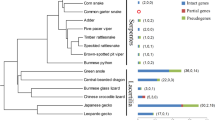Abstract
Bitter taste receptors (TAS2Rs) enable animals to detect and avoid toxins in the environment, including noxious defense compounds produced by plants. This suggests that TAS2Rs are under complex pressures from natural selection. To investigate these pressures, we examined signatures of selection in the primate TAS2R38 gene. Whole-gene (1,002 bp) sequences from 40 species representing all major primate taxa uncovered extensive variation. Nucleotide substitutions occurred at 448 positions, resulting in 201 amino acid changes. Two single-nucleotide deletions, one three-nucleotide in-frame deletion, and one premature stop codon were also observed. The rate of non-synonymous substitution (ω = dN/dS), was high in TAS2R38 (ω = 0.60) compared to other genes, but significantly lower than expected under neutrality (P = 4.0 × 10−9), indicating that purifying selection has maintained the basic structure of the receptor. However, differences were present among receptor subregions. Non-synonymous rates were significantly lower than expected in transmembrane domains (ω = 0.55, P = 1.18 × 10−12) and internal loops (ω = 0.51, P = 7.04 × 10−5), but not external loops (ω = 1.16, P = 0.53), and evidence of positive selection was found in external loop 2, which exhibited a high rate (ω = 2.53) consistent with rapid shifts in ligand targeting. These patterns point to a history of rapid yet constrained change in bitter taste responses in the course of primate evolution.



Similar content being viewed by others
References
Adler E, Hoon MA, Mueller KL, Chandrashekar J, Ryba NJ, Zuker CS (2000) A novel family of mammalian taste receptors. Cell 100:693–702
Behrens M, Brockhoff A, Kuhn C, Bufe B, Winnig M, Meyerhof W (2004) The human taste receptor hTAS2R14 responds to a variety of different bitter compounds. Biochem Biophys Res Commun 319:479–485
Benjamini Y, Hochberg Y (1995) Controlling the false discovery rate: a practical and powerful approach to multiple testing. J R Stat Soc Ser B 57:289–300
Bufe B, Hofmann T, Krautwurst D, Raguse JD, Meyerhof W (2002) The human TAS2R16 receptor mediates bitter taste in response to beta-glucopyranosides. Nat Genet 32:397–401
Chandrashekar J, Mueller KL, Hoon MA, Adler E, Feng L, Guo W, Zuker CS, Ryba NJ (2000) T2Rs function as bitter taste receptors. Cell 100:703–711
Chiarelli B (1963) Sensitivity to P.T.C. (phenyl-thio-carbamide) in primates. Folia Primatol 1:73–87
Eaton JW, Gavan JA (1965) Sensitivity to P-T-C among primates. Am J Phys Anthropol 23:381–388
Felsenstein J (2007) PHYLIP (Phylogeny Inference Package) version 3.65. Distributed by the author. Department of Genome Sciences, University of Washington, Seattle
Fischer A, Gilad Y, Man O, Pääbo S (2005) Evolution of bitter taste receptors in humans and apes. Mol Biol Evol 22:432–436
Floriano W, Hall S, Vaidehi N, Kim U, Drayna D, Goddard W (2006) Modeling the human PTC bitter-taste receptor interactions with bitter tastants. J Mol Model 12:931–941
Furlong RF, Yang Z (2008) Diversifying and purifying selection in the peptide binding region of DRB in mammals. J Mol Evol 66:384–394
Hoon MA, Adler E, Lindemeier J, Battey JF, Ryba NJ, Zuker CS (1999) Putative mammalian taste receptors: a class of taste-specific GPCRs with distinct topographic selectivity. Cell 96:541–551
Ivanov AA, Barak D, Jacobson KA (2009) Evaluation of homology modeling of G-protein-coupled receptors in light of the A(2A) adenosine receptor crystallographic structure. J Med Chem 52:3284–3294
Kim UK, Jorgenson E, Coon H, Leppert M, Risch N, Drayna D (2003) Positional cloning of the human quantitative trait locus underlying taste sensitivity to phenylthiocarbamide. Science 299:1221–1225
Kim U, Wooding S, Ricci D, Jorde LB, Drayna D (2005) Worldwide haplotype diversity and coding sequence variation at human bitter taste receptor loci. Hum Mutat 26:199–204
Meyerhof W, Batram C, Kuhn C, Brockhoff A, Chudoba E, Bufe B, Appendino G, Behrens M (2010) The molecular receptive ranges of human TAS2R bitter taste receptors. Chem Senses 35:157–170
Okada T, Ernst OP, Palczewski K, Hofmann KP (2001) Activation of rhodopsin: new insights from structural and biochemical studies. Trends Biochem Sci 26:318–324
Palczewski K, Kumasaka T, Hori T, Behnke CA, Motoshima H, Fox BA, Le Trong I, Teller DC, Okada T, Stenkamp RE, Yamamoto M, Miyano M (2000) Crystal structure of rhodopsin: A G protein-coupled receptor. Science 289:739–745
Parry CM, Erkner A, le Coutre J (2004) Divergence of T2R chemosensory receptor families in humans, bonobos, and chimpanzees. Proc Natl Acad Sci USA 101:14830–14834
Purvis A (1995) A composite estimate of primate phylogeny. Philos Trans R Soc Lond B Biol Sci 348:405–421
Sainz E, Cavenagh M, Gutierrez J, Battey J, Northup J, Sullivan S (2007) Functional characterization of human bitter taste receptors. Biochem J 403:537–543
Shi P, Zhang J (2006) Contrasting modes of evolution between vertebrate sweet/umami receptor genes and bitter receptor genes. Mol Biol Evol 23:292–300
Shi P, Zhang J, Yang H, Zhang YP (2003) Adaptive diversification of bitter taste receptor genes in Mammalian evolution. Mol Biol Evol 20:805–814
Soranzo N, Bufe B, Sabeti PC, Wilson JF, Weale ME, Marguerie R, Meyerhof W, Goldstein DB (2005) Positive selection on a high-sensitivity allele of the human bitter-taste receptor TAS2R16. Curr Biol 15:1257–1265
Strotmann R, Schrock K, Boselt I, Staubert C, Russ A, Schoneberg T (2011) Evolution of GPCR: change and continuity. Mol Cell Endocrinol 331:170–178
Suzuki N, Sugawara T, Matsui A, Go Y, Hirai H, Imai H (2011) Identification of non-taster Japanese macaques for a specific bitter taste. Primates 51:285–289
Toll-Riera M, Laurie S, Alba MM (2011) Lineage-specific variation in intensity of natural selection in mammals. Mol Biol Evol 28:383–398
Vaidehi N, Floriano WB, Trabanino R, Hall SE, Freddolino P, Choi EJ, Zamanakos G, Goddard WA (2002) Prediction of structure and function of G protein-coupled receptors. Proc Natl Acad Sci USA 99:12622–12627
Wang X, Thomas SD, Zhang J (2004) Relaxation of selective constraint and loss of function in the evolution of human bitter taste receptor genes. Hum Mol Genet 13:2671–2678
Wooding S, Kim UK, Bamshad MJ, Larsen J, Jorde LB, Drayna D (2004) Natural selection and molecular evolution in PTC, a bitter-taste receptor gene. Am J Hum Genet 74:637–646
Wooding S, Bufe B, Grassi C, Howard M, Stone A, Vazquez M, Dunn D, Meyerhof W, Weiss R, Bamshad M (2006) Independent evolution of bitter-taste sensitivity in humans and chimpanzees. Nature 440:930–934
Wooding S, Gunn H, Ramos P, Thalmann S, Meyerhof W (2010) Genetics and bitter taste responses to goitrin, a plant toxin found in vegetables. Chem Senses 35:685–692
Xia X, Xie Z (2001) DAMBE: software package for data analysis in molecular biology and evolution. J Hered 92:371
Xia X, Xie Z, Salemi M, Chen L, Wang Y (2003) An index of substitution saturation and its application. Mol Phylogenet Evol 26:1
Yang Z (2007) PAML 4: phylogenetic Analysis by Maximum Likelihood. Mol Biol Evol 24:1586
Yang Z, Wong W, Nielsen R (2005) Bayes empirical bayes inference of amino acid sites under positive selection. Mol Biol Evol 22:1107–1118
Author information
Authors and Affiliations
Corresponding author
Additional information
DNA sequences analyzed in this study are deposited in GenBank with IDs JQ272198–JQ272237.
Rights and permissions
About this article
Cite this article
Wooding, S. Signatures of Natural Selection in a Primate Bitter Taste Receptor. J Mol Evol 73, 257–265 (2011). https://doi.org/10.1007/s00239-011-9481-0
Received:
Accepted:
Published:
Issue Date:
DOI: https://doi.org/10.1007/s00239-011-9481-0




